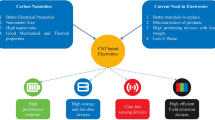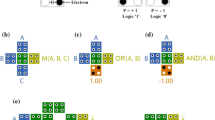Abstract
This paper presents a novel power and energy-efficient carbon nanotube field-effect transistor (CNTFET)-based design of a quaternary magnitude comparator for single and double digits. It also proposes an improved circuit of the ternary single-digit comparator and a novel design of the double-digit ternary comparator. The designs make use of the pass transistor logic and transmission gates, resulting in a more power and energy-efficient design with a lower number of CNTFETs when compared with existing designs. Besides, this paper also proposes a generalized circuit of magnitude comparator for multiple digits. The proposed circuits are simulated in HSPICE using the 32 nm CNTFET model presented by Stanford University. Average power and propagation delays are observed and the power-delay-product (PDP) is calculated in each case. The impact of process parameter variations has been analyzed through Monte Carlo simulation and has been presented in the form of two-dimensional graphs.




















Similar content being viewed by others
Data Availability
All data generated or analyzed during this study are included within this article.
References
N.H. Bastani, M.H. Moaiyeri, K. Navi, An energy- and area-efficient approximate ternary adder based on CNTFET switching logic. Circuits Syst. Signal Process. 37(5), 1863–1883 (2018). https://doi.org/10.1007/s00034-017-0627-1
A.K. Dadoria, K. Khare, Design and analysis of low-power adiabatic logic circuits by using CNTFET Technology. Circuits Syst. Signal Process. 38(9), 4338–4356 (2019). https://doi.org/10.1007/s00034-019-01059-4
A. Daraei, S.A. Hosseini, Novel energy-efficient and high-noise margin quaternary circuits in nanoelectronics. AEU-Int. J. Electron. C. 105, 145–162 (2019). https://doi.org/10.1016/j.aeue.2019.04.012
J. Deng, H.S.P. Wong, A compact SPICE model for carbon-nanotube field-effect transistors including nonidealities and its application—part II: full device model and circuit performance benchmarking. IEEE Trans. Electron Devices. 54(12), 3195–3205 (2007). https://doi.org/10.1109/TED.2007.909043
J. Deng, H.S.P. Wong, A compact SPICE model for carbon-nanotube field-effect transistors including nonidealities and its application—part I: model of the intrinsic channel region. IEEE Trans. Electron Devices. 54(12), 3186–3194 (2007). https://doi.org/10.1109/TED.2007.909030
A. Dhande, V.R. Ghiye, V.T. Ingole, Ternary digital system: concepts and applications. SM Medical Technologies Private Limited. Chapter 5 (September), 131 (2014)
S.A. Ebrahimi, M.R. Reshadinezhad, A. Bohlooli, M. Shahsavari, Efficient CNTFET-based design of quaternary logic gates and arithmetic circuits. Microelectron. J. 53, 156–166 (2016). https://doi.org/10.1016/j.mejo.2016.04.016
Y.A. Gaidhani, M.N. Kalbande, Design of some useful logic blocks using quaternary algebra. Int. J. Adv. Comput. Netw. Secur. 1(1), 412–417 (2019)
S.A. Hosseini, S. Etezadi, A novel very low-complexity multi-valued logic comparator in nanoelectronics. Circuits Syst. Signal Process. 39(1), 223–244 (2020). https://doi.org/10.1007/s00034-019-01158-2
I. Jahangir, D.M.N. Hasan, M.S. Reza, Design of some quaternary combinational logic blocks using a new logic system, in IEEE Region 10 Annual International Conference, Proceedings/TENCON. 1–6 (2009). https://doi.org/10.1109/TENCON.2009.5396095
A. Lin, G. Wan, J. Deng, H.-S.P. Wong, A quick user guide on stanford university carbon nanotube field effect transistors (CNFET) HSPICE model. v.2.2.1. 1–13 (2009)
S. Lin, Y. Bin Kim, F. Lombardi, CNTFET-based design of ternary logic gates and arithmetic circuits. IEEE Trans Nanotechnol. 10(2), 217–225 (2011). https://doi.org/10.1109/TNANO.2009.2036845
S. Lin, Y.-B. Kim, F. Lombardi, A novel CNTFET-based ternary logic gate design, in 2009 52nd IEEE International Midwest Symposium on Circuits and Systems, IEEE (2009), pp. 435–438. https://doi.org/10.1109/MWSCAS.2009.5236063
M.H. Moaiyeri, A. Doostaregan, K. Navi, Design of energy-efficient and robust ternary circuits for nanotechnology. IET Circuits Devices Syst. 5(4), 285–296 (2011). https://doi.org/10.1049/iet-cds.2010.0340
M.H. Moaiyeri, K. Navi, O. Hashemipour, Design and evaluation of CNFET-based quaternary circuits. Circuits Syst. Signal Process. 31(5), 1631–1652 (2012). https://doi.org/10.1007/s00034-012-9413-2
M.H. Moaiyeri, A. Rahi, F. Sharifi, K. Navi, Design and evaluation of energy-efficient carbon nanotube FET-based quaternary minimum and maximum circuits. J. Appl. Res. Technol. 15(3), 233–241 (2017). https://doi.org/10.1016/j.jart.2016.12.006
S.L. Murotiya, A. Gupta, S. Vasishth, Novel design of ternary magnitude comparator using CNTFETs, in 11th IEEE India Conference: Emerging Trends and Innovation in Technology, INDICON 2014. (1), 1–4 (2015). https://doi.org/10.1109/INDICON.2014.7030447.
A. Paul, B. Pradhan, CNTFET-based design of ternary logic gates with interchangeable standard positive and negative ternary output. Eng. Res. Express. 3(3), 35002 (2021). https://doi.org/10.1088/2631-8695/ac0fc6
S. Rani, B. Singh, R. Devi, CNTFET based ternary 1-trit and 2-trit comparators for low power high-performance applications. Trans. Electr. Electron. Mater. 22(6), 734–749 (2021). https://doi.org/10.1007/s42341-021-00292-6
A. Raychowdhury, K. Roy, Carbon-nanotube-based voltage-mode multiple-valued logic design. IEEE Trans Nanotechnol. 4(2), 168–179 (2005). https://doi.org/10.1109/TNANO.2004.842068
Z.T. Sandhie, J.A. Patel, F.U. Ahmed, Investigation of multiple-valued logic technologies for beyond-binary era. ACM Comput Surv (2021). https://doi.org/10.1145/3431230
F. Sharifi, M.H. Moaiyeri, K. Navi, N. Bagherzadeh, Quaternary full adder cells based on carbon nanotube FETs. J Comput Electron. 14(3), 762–772 (2015). https://doi.org/10.1007/s10825-015-0714-0
K. Sridharan, S. Gurindagunta, V. Pudi, Efficient multiternary digit adder design in CNTFET technology. IEEE Trans Nanotechnol. 12(3), 283–287 (2013). https://doi.org/10.1109/TNANO.2013.2251350
B. Srinivasu, K. Sridharan, Carbon nanotube FET-based low-delay and low-power multi-digit adder designs. IET Circuits Devices Syst. 11(4), 352–364 (2017). https://doi.org/10.1049/iet-cds.2016.0013
S. Tabrizchi, F. Sharifi, A.H. Badawy, Z.M. Saifullah, Enabling energy-efficient ternary logic gates using CNFETs, in 2017 IEEE 17th International Conference on Nanotechnology, NANO 2017. 542–547 (2017). https://doi.org/10.1109/NANO.2017.8117467
C. Vudadha, P.P. Sai, V. Sreehari, M.B. Srinivas, CNFET based ternary magnitude comparator, in 2012 International Symposium on Communications and Information Technologies, ISCIT 2012. (1), 942–946 (2012). https://doi.org/10.1109/ISCIT.2012.6381040
Author information
Authors and Affiliations
Corresponding author
Ethics declarations
Conflict of interest
The authors declare that they have no known competing financial interests or personal relationships that could have appeared to influence the work reported in this paper.
Additional information
Publisher's Note
Springer Nature remains neutral with regard to jurisdictional claims in published maps and institutional affiliations.
Rights and permissions
Springer Nature or its licensor (e.g. a society or other partner) holds exclusive rights to this article under a publishing agreement with the author(s) or other rightsholder(s); author self-archiving of the accepted manuscript version of this article is solely governed by the terms of such publishing agreement and applicable law.
About this article
Cite this article
Paul, A., Pradhan, B. Design of CNTFET-Based Ternary and Quaternary Magnitude Comparator. Circuits Syst Signal Process 42, 5634–5662 (2023). https://doi.org/10.1007/s00034-023-02380-9
Received:
Revised:
Accepted:
Published:
Issue Date:
DOI: https://doi.org/10.1007/s00034-023-02380-9




